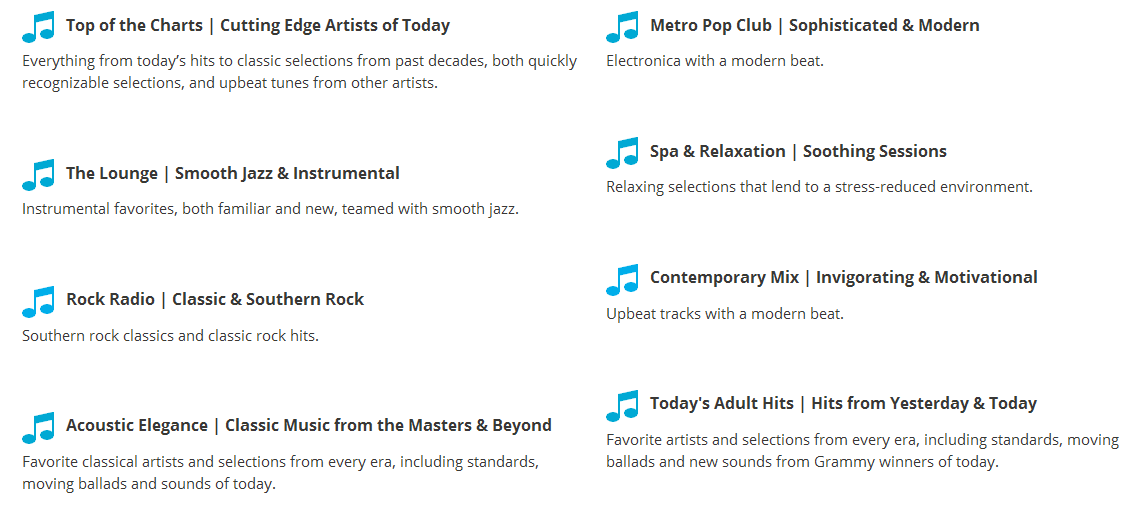
When you chose the background music for your commercial location, what was your process?
Did you select whatever music service was easiest? Flip on the radio? Did you pick a music style you liked or leave it to an employee to choose the playlist? Or, did you just leave the store in silence or otherwise, not think about what it sounds like in your location?
As you go through those questions, you may realize that when you selected your overhead music, you didn’t go through much of a process at all. You may have rushed through it and sought the simplest solution.
While this may have accelerated your decision making, it probably didn’t do much to benefit your business. Because failing to go through a thoughtful selection process stops you from receiving all the advantages of having the right background music.
The Benefit of Playing the Right Background Music
Background music may not be at the forefront of your business, but it is an essential element.
Your overhead music playlist sets the tone for your business and communicates messages with staff, customers, clients, and visitors. Using the right background music can:
- Increase sales
- Encourage customers and visitors to stay longer or move faster
- Decrease customer stress
- Direct purchasing habits
- Improve employee satisfaction
- Increase employee productivity
- Reinforce branding
- Protect your business from legal ramifications
So, you shouldn’t rush through your overhead music plans. You should go through a thoughtful process to choose the music that works best for your business, staff, and guests.
To find out if you are using the right background music for your business, ask yourself the following questions.
Is Your Music the Right Genre for Your Target Audience?
It’s easy to want to choose music that you like when selecting the overhead music for your business. But the sounds in your store shouldn’t be what you like; it should be about what your target customers like.
You should already have created a buyer persona or customer avatar that defines your target audience. Consider that target audience and select music they would enjoy.
Is Your Overhead Music the Right Genre for Your Industry?
It’s likely that your target audience may have more than one musical interest. So you also need to consider the industry that your business belongs to.
Match your music to what customer will expect to find at your type of business. For example, if you own a spa, your target audience may like pop music. But while they are in a spa, they would expect to find more mild, ambient music.
Browse our library of overhead music genres to get ideas about what type of playlist would work for your business.

Is Your Background Music the Right Tempo?
Part of choosing the correct musical preference for your business is selecting songs that have the right tempo and energy for your location. The tempo and rhythm of your background music impact customers more than you might think.
Studies have found that music tempo can affect the shopping habits of customers. High-tempo music often leads customers to move through the store at a faster pace, while low-tempo music causes customers to spend more time shopping or dining. Make sure the tempo of your overhead music matches the type of experience you want to create for your customers.
Is Your Music the Right Volume?
The music your choose is as important as how loudly you play it. Your overhead music should be the appropriate volume for your establishment and consumer base.
There isn’t a perfect background music volume. To determine the correct volume for your overhead music, go back to your demographic and shopping experience considerations. Match your volume to what matches your target customer and goals.
Is Your Music Mixed in with the Right Messaging?
Another way to miss an opportunity with overhead music is failing to mix in messages with your music. Integrating targeted messages into your overhead music allows you to connect with an extremely engaged, in-store audience.
You can use messages to share promotions, promote events, direct your customers to take action, and share positive reviews about your products and services.
Get some ideas for how you can infuse targeted messages into your overhead music programming by browsing our overhead message samples.

Is Your Music Annoying Your Employees?
While the background music of your commercial location should cater to your visitors, you can’t forget about your employees. Your staff probably spends between 6-9 hours listening to your overhead music during their shift, so it should be no surprise that music has an impact on your employees.
Listening to the same music over and over can negatively affect employees. It can decrease employee satisfaction and productivity. So, don’t fail to consider staff experience while selecting your in-store playlist. Make sure your playlists are long enough that they don’t regularly repeat themselves and create listener fatigue.
Is Your Background Music Legal?
The final question that you need to ask yourself about your overhead music may be the most important. Many businesses don’t realize that they can find themselves in legal trouble due to their background music.
Playing copyright music–which many businesses do when they play the radio, CDs, satellite radio stations, and personally curated playlists–is illegal when you don’t have the correct license.
In Florida, 25 business were sued for playing copyright music because they were unaware of these laws. Make sure you are playing music that is legally acceptable, so you don’t find yourself in the same trouble.
It’s likely that as you went through these questions, you identified a few places where your overhead music isn’t fully serving your customers, staff, or business. So, use these considerations to improve your background music to better suit your business goals and customers.
Not sure how to make the changes your overhead music needs?
Contact Spectrio to get a free consultation that will tell where you are missing the mark and how you can make changes to improve your store, customer satisfaction, employee productivity, and legal exposure.